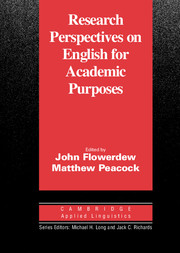Book contents
- Frontmatter
- Contents
- List of contributors
- Series editors' preface
- Preface
- I ISSUES IN ENGLISH FOR ACADEMIC PURPOSES
- II THE ENGLISH FOR ACADEMIC PURPOSES CURRICULUM
- Introduction to Part II
- 11 The EAP curriculum: Issues, methods, and challenges
- 12 Twenty years of needs analyses: Reflections on a personal journey
- 13 The curriculum renewal process in English for academic purposes programmes
- 14 Team-teaching in EAP: Changes and adaptations in the Birmingham approach
- 15 Does the emperor have no clothes? A re-examination of grammar in content-based instruction
- 16 The specialised vocabulary of English for academic purposes
- 17 Language learning strategies and EAP proficiency: Teacher views, student views, and test results
- 18 Issues in EAP test development: What one institution and its history tell us
- 19 Teaching writing for academic purposes
- 20 Reading academic English: Carrying learners across the lexical threshold
- 21 Incorporating reading into EAP writing courses
- 22 The development of EAP oral discussion ability
- 23 Second language lecture comprehension research in naturalistic controlled conditions
- 24 Designing tasks for developing study competence and study skills in English
- 25 Promoting EAP learner autonomy in a second language university context
- References
- Index
24 - Designing tasks for developing study competence and study skills in English
Published online by Cambridge University Press: 05 October 2012
- Frontmatter
- Contents
- List of contributors
- Series editors' preface
- Preface
- I ISSUES IN ENGLISH FOR ACADEMIC PURPOSES
- II THE ENGLISH FOR ACADEMIC PURPOSES CURRICULUM
- Introduction to Part II
- 11 The EAP curriculum: Issues, methods, and challenges
- 12 Twenty years of needs analyses: Reflections on a personal journey
- 13 The curriculum renewal process in English for academic purposes programmes
- 14 Team-teaching in EAP: Changes and adaptations in the Birmingham approach
- 15 Does the emperor have no clothes? A re-examination of grammar in content-based instruction
- 16 The specialised vocabulary of English for academic purposes
- 17 Language learning strategies and EAP proficiency: Teacher views, student views, and test results
- 18 Issues in EAP test development: What one institution and its history tell us
- 19 Teaching writing for academic purposes
- 20 Reading academic English: Carrying learners across the lexical threshold
- 21 Incorporating reading into EAP writing courses
- 22 The development of EAP oral discussion ability
- 23 Second language lecture comprehension research in naturalistic controlled conditions
- 24 Designing tasks for developing study competence and study skills in English
- 25 Promoting EAP learner autonomy in a second language university context
- References
- Index
Summary
Any consideration of how to design appropriate activities for helping students to study successfully in English has to be based on an understanding of two fundamental factors, namely, (i) what effective study involves, and, (ii) what an effective approach to learning to study entails – conceptions, in other words, of the underlying ‘what’ and ‘how’, respectively, of this area of the design of activities. Obviously, numerous other factors also play an important role in the design process, such as sequencing, variety, feasibility, level and so on, but ultimately, everything depends on whether the materials have validity in terms of the underlying view of studying and learning to study on which they are based. Unless these concepts are sound and appropriate ones, the materials, however technically well-developed, will simply be misdirected.
In what follows, therefore, we will first of all briefly consider the main ‘messages’ of research about the nature of effective study. We will then present a rationale for an approach to helping students master such study processes. The remainder will focus on how these concepts can be taken into account in an overall framework for the design of study development activities.
The nature of effective study
There is general agreement in the EAP research literature (see, e.g., Dunkel, 1988b; Johns, 1981; Braine, 1989, etc.) that effective study involves the successful use of techniques such as how to take notes, skim and scan, construct a bibliography and so on – in other words, a command of what are commonly referred to as study ‘skills’.
- Type
- Chapter
- Information
- Research Perspectives on English for Academic Purposes , pp. 375 - 389Publisher: Cambridge University PressPrint publication year: 2001
- 1
- Cited by

